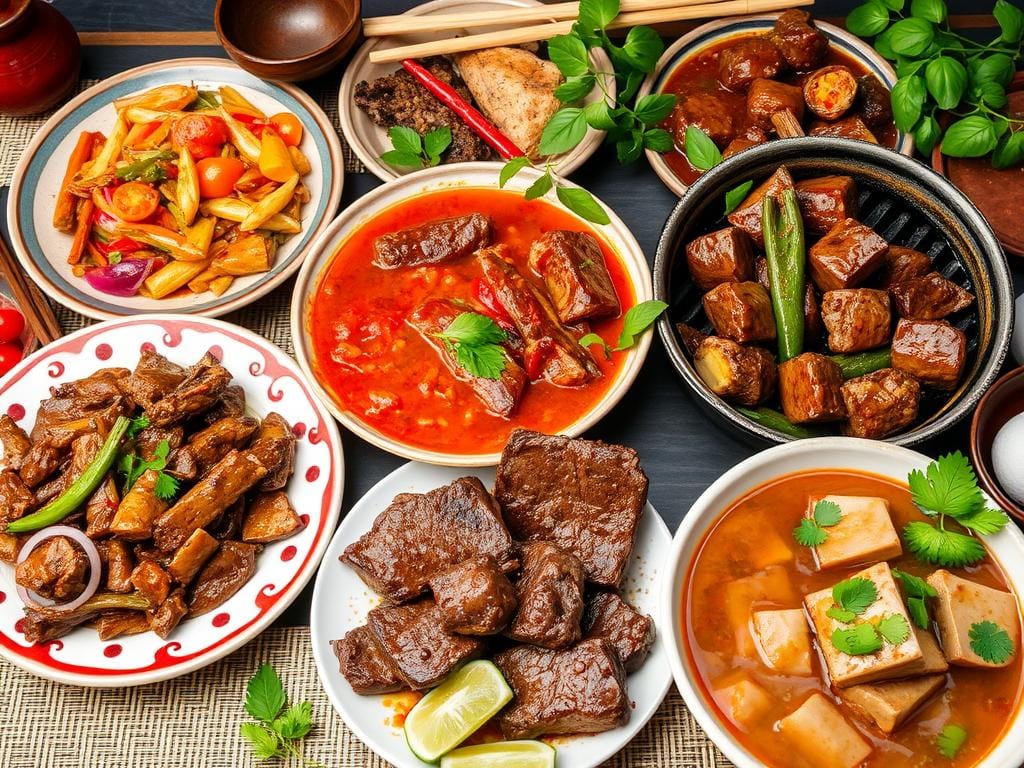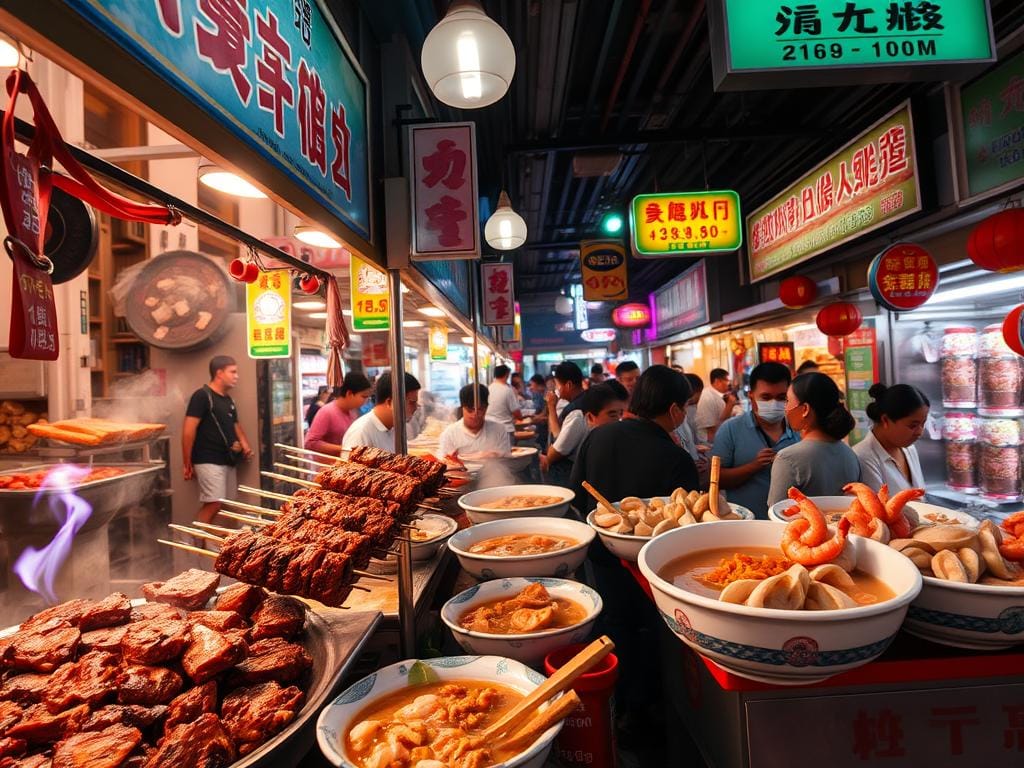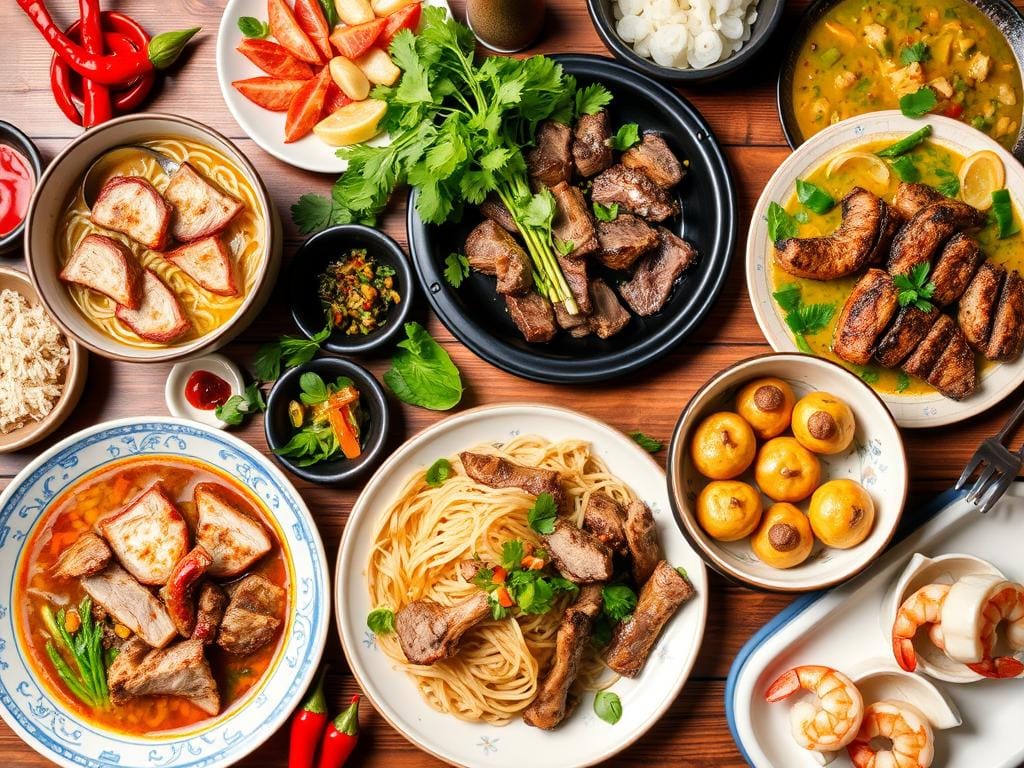I love exploring the world of food, and Asia’s cuisine is a big part of that. From China’s spicy dishes to India’s fragrant curries, the flavors are incredible. What fascinates me most is how different cultures use meat in their cuisines. So, what kind of meat do they eat in Asia?
In this guide, we’ll answer the question: What kind of meat do they eat in Asia? From the tender poultry of Southeast Asia to the smoky grilled kebabs of West Asia, we’ll explore the diverse meats loved across the region. Join us as we uncover the unique flavors, cooking techniques, and cultural traditions that make Asian meat dishes so special and captivating.
Table of contents
- Key Takeaways
- Introduction to Asian Meat Cuisine
- Poultry: Chicken and Duck across Asia
- Beef: Variations and Cooking Techniques
- Seafood: A Protein Alternative in Coastal Areas
- Street Food: Quick Meat-Based Eats
- Celebratory Dishes: Meat in Festivals and Ceremonies
- Sustainability: The Future of Meat Consumption in Asia
- Conclusion: The Diversity of Asian Meat Dishes
- FAQ
Key Takeaways
- Asia is home to a diverse array of regional cuisines, with China alone boasting 63 distinct culinary styles.
- Meat plays a significant role in Asian dietary traditions, with a wide range of proteins and preparation methods across different regions.
- Discover the unique flavors, cooking techniques, and cultural significance of various meat dishes in Asian cuisine.
- Explore the diverse range of poultry, pork, beef, seafood, and even non-native meat options found in Asian culinary traditions.
- Understand the health and sustainability considerations surrounding meat consumption in Asia.
Introduction to Asian Meat Cuisine
Meat is key in Asian cuisine, showing the area’s rich culture, geography, and history.Many dishes across Asia feature it, emphasizing its importance. Knowing about the types of meat eaten gives us a peek into the continent’s culinary world.
The Importance of Meat in Asian Dietary Traditions
Meat has always been a staple in Asian diets, providing essential protein and holding significant cultural and religious importance. Each region has its own way of cooking and flavoring meat, using local ingredients and traditional methods. From the grilled meats of West Asia to the stir-fries of East Asia, what kind of meat do they eat in Asia? varies greatly, reflecting the diversity of the continent’s culinary traditions. For a deep dive into how food reflects culture, check out our guide to authentic Asian street meat.
Overview of Popular Meat Types
- Poultry: Chicken and duck are favorites in Asia, with each place having its own special dishes and cooking styles.
- Pork: Pork is a big deal in many Asian countries, with its own set of regional specialties and cultural importance.
- Beef: Beef dishes in Asia are varied, showing different cooking methods and tastes, appealing to many.
- Seafood: Coastal areas in Asia use a lot of fish and other sea foods as meat alternatives.
- Some Asian cooking traditions value lamb and goat, even though these meats are not as common.
- Exotic Meats: Some parts of Asia also use unique and unfamiliar meats, showing the area’s culinary variety.
The variety in Asian meat dishes shows the region’s traditional ingredients, culinary diversity, and food customs. Exploring these dishes takes us on a flavorful journey through Asia’s culinary traditions.
Poultry: Chicken and Duck across Asia
Chicken and duck are key in Asian cuisine. They star in dishes like Thai green curry and Vietnamese pho ga. The famous Peking duck is a symbol of Chinese delicacies.These recipes highlight the versatility of poultry in Asian cuisine. Learn more about complementary flavors in our dense bean salad recipes, which pair beautifully with poultry-based dishes.
Traditional Chicken Dishes in Southeast Asia
In the Southeast Asian kitchen, chicken is a favorite. In Thailand, green curry with chicken is a favorite. Vietnam’s pho ga is a beloved chicken noodle soup. Families love Indonesia’s ayam kecap, a sweet soy sauce chicken dish.
Popular Duck Varieties and Preparations
- Peking Duck: A renowned Chinese dish featuring crispy-skinned roasted duck served with thin pancakes, scallions, and hoisin sauce.
- Cantonese-Style Braised Duck: Succulent duck simmered in a flavorful soy sauce-based broth, often paired with preserved vegetables.
- Confit of duck uses a French-influenced technique, slowly cooking duck legs in their own fat to create a rich, melt-in-your-mouth texture.
Diverse duck preparations show the creativity in Asian cooking. They offer unique flavors and textures that delight food lovers.
Beef: Variations and Cooking Techniques
In Asian cuisine, beef dishes are as varied and tasty as the places they come from. From Japan’s famous wagyu to Korea’s delicious bulgogi, each meat dish highlights the continent’s culinary richness. Discover unique recipes that celebrate beef, such as the beef brisket sandwich, a hearty option inspired by global flavors.
Unique Beef Dishes from Different Regions
In Indonesia, the islands’ culinary diversity shines through in their beef dishes. With over 1,300 ethnic groups, each with its own cooking ways, the country’s 18,000 islands are a treasure trove of flavors. A standout dish is rendang, a slow-cooked stew from the Minangkabau region, full of spices.
Cooking Methods for Tender and Flavorful Beef
- Asian cuisines use many cooking methods to get the best texture and taste. These include grilling, stir-frying, and slow-cooking.
- The Taiwanese-born Mongolian beef dish is grilled in batches to get a nice sear. This prevents the meat from steaming instead.
- After grilling, the beef is mixed with a tasty sauce. This sauce is made with kecap manis (sweet soy sauce), garlic, and spices. It makes the dish tender and full of flavor.

By learning these cooking methods and exploring the diverse meat dishes across Asia, you can start a culinary journey. This journey celebrates the region’s rich gastronomic heritage.
Seafood: A Protein Alternative in Coastal Areas
In Asia’s coastal areas, seafood is a key protein source and plays a central role in traditional cuisines. From Japan’s sushi and sashimi to the wide variety of shellfish and seafood dishes across the continent, fish and marine life are integral to understanding what kind of meat do they eat in Asia. Explore related recipes, like delicious fish and rice dishes, for inspiration.
Importance of Fish in Asian Cuisine
Asian cooking traditions highly value fish, preparing it in diverse ways such as raw, grilled, fried, or stewed. This shows the unique tastes and food customs of each area. People enjoy fish in various forms, from Japan’s sushi to China’s steamed dishes and India’s curries. It’s a staple that feeds both the body and soul.
Types of Seafood Commonly Eaten in Asia
- Shellfish like clams, oysters, mussels, and shrimp are popular across Asia, frequently featured in stir-fries, soups, and grilled dishes.
- Cephalopods such as octopus, squid, and cuttlefish are celebrated for their delicate textures and unique flavors, appearing in dishes like sashimi, fried calamari, and braised preparations.
- Finfish, including saltwater and freshwater varieties like tuna, salmon, mackerel, and tilapia, are cherished for their nutritional value and versatility in Asian cuisine.
The rich tapestry of Asian seafood cuisine shows the region’s deep connection to the sea. It also highlights the creativity of its cooks in turning traditional ingredients into delicious dishes.
| Seafood Type | Popular Preparations | Regions |
|---|---|---|
| Tuna | Sashimi, Sushi, Grilled, Steamed | Japan, Korea, Southeast Asia |
| Shrimp | Stir-fries, Curries, Grilled, Deep-fried | China, India, Thailand, Vietnam |
| Octopus | Sashimi, Grilled, Braised | Japan, Korea, Mediterranean Asia |
Street Food: Quick Meat-Based Eats
Asian cuisine is famous for its lively street food scene. Here, a wide range of meat dishes shine. From satay in Southeast Asia to yakitori in Japan, these dishes are quick, tasty, and show the area’s rich food traditions. For additional street food insights, explore our feature on Asian-inspired snacks.
Popular Street Food Dishes Involving Meat
Satay is a key street food in Southeast Asia. It’s skewers of chicken, beef, or lamb, marinated in spices and coconut milk. In Japan, chefs prepare yakitori by grilling small chicken pieces and seasoning them with soy sauce for a flavorful dish.
Korean Bulgogi BBQ features thinly sliced beef marinated in soy sauce and sugar, then grilled for a quick, flavorful meal or a savory sandwich filling.
In India and Pakistan, cooks prepare Seekh Kebabs by seasoning meat skewers, grilling them to perfection, and serving them with mint chutney. In Bangladesh, Shami Kebabs consist of minced beef or mutton patties, pan-fried to deliver a delicious and flavorful bite.
How Street Food Reflects Local Culture
These street foods offer not only delicious flavors but also a glimpse into Asia’s rich cultural diversity. What kind of meat do they eat in Asia? Inasal from the Philippines, for example, features chicken marinated in vinegar and spices, showcasing the unique flavors of the region. Similarly, Ping Pa from Laos presents grilled fish with herbs, emphasizing the wide variety of meats and cooking styles found across the continent.
Taiwan’s night markets are famous for their meat dishes. Across Asia, street food shows the rich mix of local cultures, ingredients, and traditions. These dishes are not just quick and tasty but also a great way to enjoy Asian cuisine, meat dishes, and cultural foods.

Celebratory Dishes: Meat in Festivals and Ceremonies
Meat is key in Asian festivals and ceremonies. People make special dishes for big occasions. Celebrate culinary traditions further with stuffed bagel ideas, a unique twist on festive flavors.
Significance of Meat in Asian Celebrations
In many Asian cultures, meat has deep meaning during festivals and ceremonies. Meat dishes symbolize prosperity, fertility, and family unity. Sharing these foods strengthens cultural bonds and social ties.
Traditional Festive Meat Dishes
- In China, the Mid-Autumn Festival features the iconic mooncake, which can be filled with savory ingredients like roast pork or chicken alongside sweet lotus seed paste.
- During the Chuseok harvest festival in Korea, Songpyeon, a traditional rice cake, is often filled with ingredients like sesame seeds, red bean, and honey, reflecting the abundance of the season.
- In Japan, the Tsukimi Soba, or “Moon-viewing Soba,” is a dish of soba noodles topped with a raw egg, symbolizing the harvest moon and the cycle of life.
These ceremonial meat-based dishes are not just tasty. They also help keep cultural heritage alive. They bring communities together and celebrate the natural cycles that are part of Asian food traditions.
Sustainability: The Future of Meat Consumption in Asia
The world is now more aware of environmental issues. This awareness is leading to a focus on sustainable meat practices in Asia. Many areas are looking into alternative proteins and better farming methods. This is to tackle the challenges of ethnic gastronomy, culinary diversity, and food customs.
Emerging Trends in Sustainable Meat Practices
Plant-based diets are becoming popular in Southeast Asia, even with its high meat consumption. Health and environmental concerns are driving this change. Local startups in Thailand and Indonesia are making plant-based alternatives that fit local tastes. This makes it easier for people to choose a more eco-friendly diet.
The cultivated meat industry is also growing, with Singapore leading the way. This method grows meat cells in a lab. It aims to lessen the environmental harm of livestock farming while keeping the flavors and textures that people love.
Discover how plant-forward cooking is influencing traditional meat dishes in our guide to better bagels.
Conclusion: The Diversity of Asian Meat Dishes
Exploring Asian meat dishes reveals a world of flavors and traditions. From Cantonese to Sichuan, each dish reflects Asia’s rich culture. You’ll find everything from tender lamb kebabs to hearty yak butter tea.
Exploring Personal Preferences and Regional Flavors
As you explore Asian meat dishes, you’ll find your tastes change. Different flavors appeal to different people. This journey lets you discover new tastes and traditions.
Encouraging Culinary Adventure through Asian Meats
Exploring Asian meat dishes opens up a world of flavors. It’s a chance to try new things and learn about different cultures. Let your taste buds lead you on this exciting journey.
FAQ
1. What kind of meat do Asians eat?
Asian cuisine varies greatly by region, but common types of meat consumed across Asia include:
- Pork: Particularly common in East and Southeast Asia (China, Japan, Korea, Thailand, etc.).
- Chicken: Popular throughout Asia in dishes like curries, stir-fries, and soups.
- Beef: Often consumed in countries like Japan, Korea, and India (though beef consumption in India is less common due to cultural and religious beliefs).
- Lamb/Mutton: Eaten in parts of Central Asia, the Middle East, and India.
- Goat: Common in parts of India, Pakistan, and some Southeast Asian countries.
- Fish and Seafood: Especially common in coastal regions and island nations like Japan, China, the Philippines, and Indonesia.
2. What is the most consumed meat in Asia?
Pork is the most consumed meat in Asia, especially in China, which is the world’s largest producer and consumer of pork. Many dishes across East and Southeast Asia, such as dumplings, stir-fries, and braised dishes, incorporate it widely.
3. What do Asians mainly eat?
Asian diets are diverse, but common foods include:
- Rice: A staple food in most Asian countries, often served with vegetables, meats, or fish.
- Noodles: Popular in East and Southeast Asia, made from wheat, rice, or mung beans.
- Vegetables: Vegetables such as bok choy, spinach, and eggplant are frequently used in cooking.
- Soy products: Tofu, tempeh, and soy sauce are widely used, particularly in East Asia and Southeast Asia.
- Spices and Herbs: Asian cuisines are known for their use of fresh herbs like cilantro, basil, and mint, as well as spices like ginger, garlic, chili, and curry.
- Fish and Seafood: A significant part of many Asian diets, especially in coastal regions.
- Fruits: Tropical fruits like mango, papaya, durian, and coconut are common.
4. Is steak common in Asia?
Steak is not as common in many parts of Asia as it is in Western countries, but what kind of meat do they eat in Asia is evolving, with steak’s popularity growing in urban areas and among wealthier consumers. Japan, renowned for its wagyu beef, South Korea, and parts of China, emphasize traditions of high-quality beef, often serving steak in fine dining or Western-influenced restaurants. However, most Asian cuisines prepare beef in diverse forms, such as stir-fries, hot pots, or stews, rather than as steaks.

